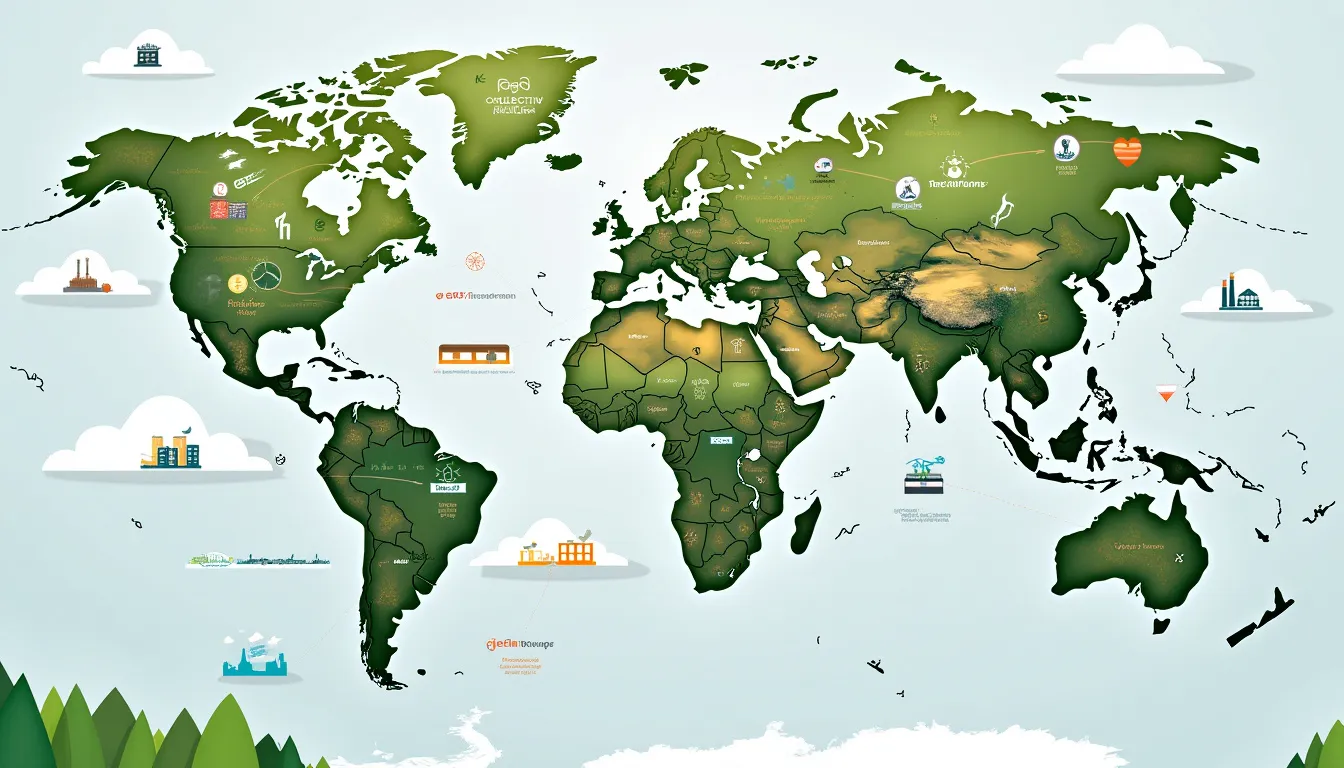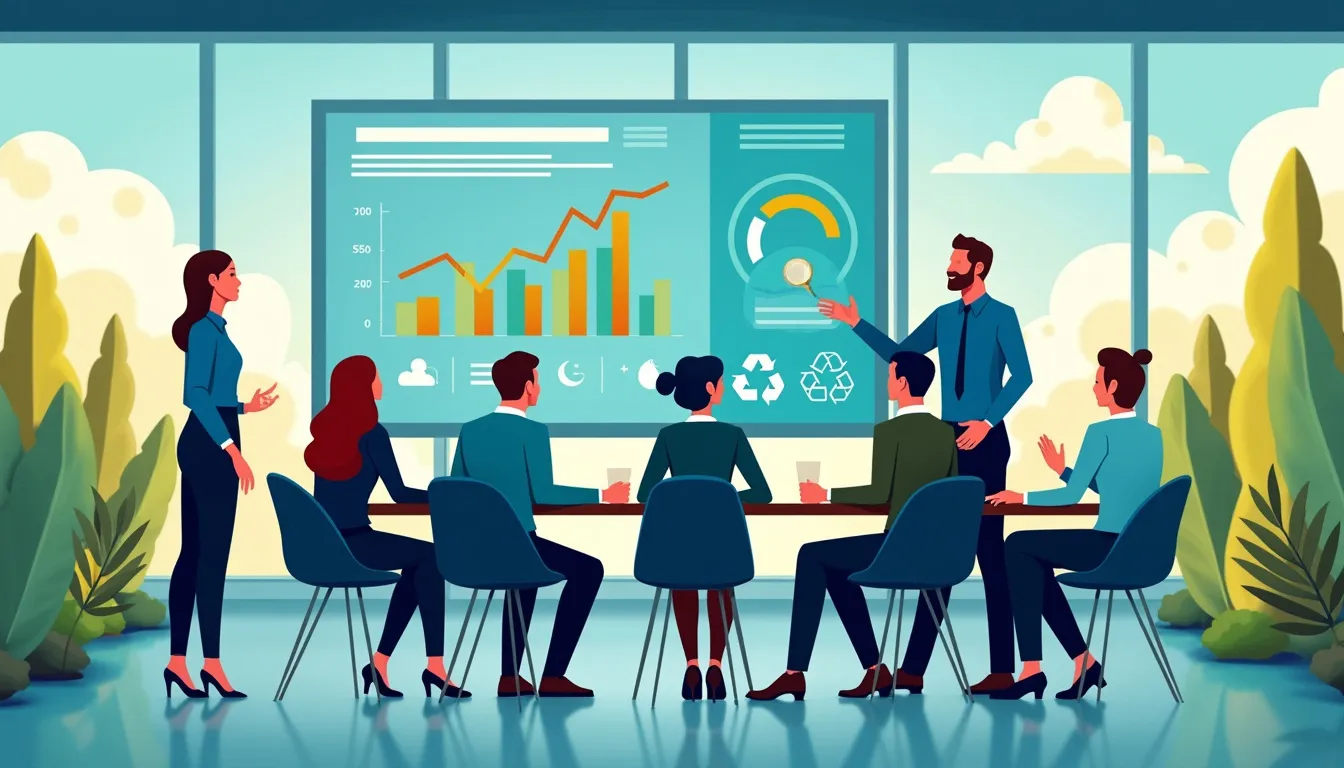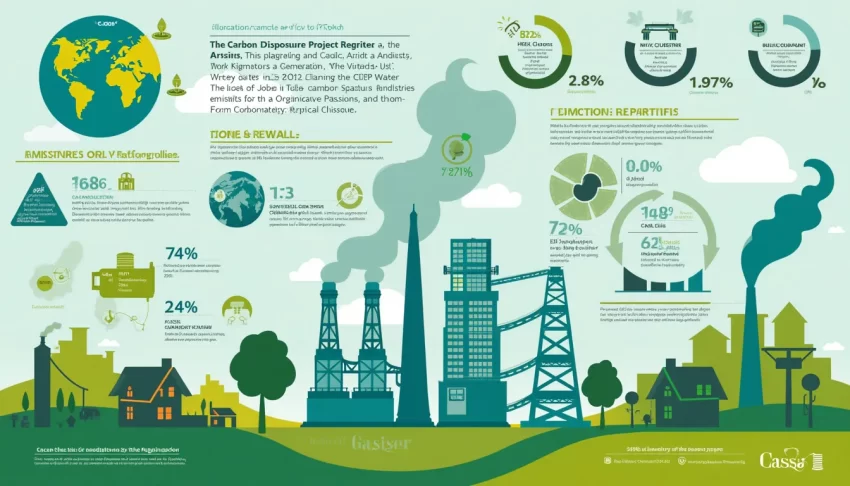In the face of escalating climate change and environmental degradation, transparency and accountability in corporate actions are more critical than ever. Enter the Carbon Disclosure Project (CDP), an initiative designed to foster these very principles by providing a platform for businesses and governments to disclose their environmental impacts. The CDP’s mission is rooted in the belief that by measuring and understanding their carbon footprints, organizations can more effectively manage and mitigate their environmental impacts, leading to more sustainable practices.
The Carbon Disclosure Project has become a cornerstone in the pursuit of environmental sustainability. Launched in 2000, CDP started as a small initiative with a bold vision: to unite influential investors and encourage companies to disclose their carbon emissions data. Over the years, it has evolved into a global movement, encompassing not just carbon emissions, but also water security, deforestation, and supply chain impacts. Today, CDP boasts the world’s most comprehensive collection of self-reported environmental data, serving as a vital resource for stakeholders across the globe.
Understanding the significance of the Carbon Disclosure Project requires us to delve into its origins and evolution. Initially, CDP’s primary goal was to gather crucial carbon emissions data from companies, providing a clear picture of their environmental footprints. As the climate crisis intensified, the project’s scope broadened to include other environmental metrics, thus offering a more holistic view of corporate environmental impact. This expansion reflects a growing recognition that effective climate action necessitates a comprehensive approach, encompassing various aspects of environmental stewardship.
The Carbon Disclosure Project’s ability to drive change lies in its unique, data-driven approach. By compelling companies and governments to be transparent about their environmental impacts, CDP not only promotes accountability but also paves the way for informed decision-making and robust climate strategies. For businesses, participating in the CDP is not merely a compliance exercise; it’s an opportunity to demonstrate leadership in sustainability, gain insights into risks and opportunities, and enhance their reputation among increasingly eco-conscious consumers and investors.
As we navigate the complexities of climate change, initiatives like the Carbon Disclosure Project offer a beacon of hope. They empower organizations to take meaningful steps towards sustainability, fostering a collaborative effort to protect our planet for future generations. By understanding and engaging with the CDP, businesses and individuals alike can contribute to a more transparent, responsible, and resilient global economy.
Introduction to the Carbon Disclosure Project
What is the Carbon Disclosure Project?
The Carbon Disclosure Project (CDP) is a global nonprofit organization that aids companies and cities in disclosing their environmental impacts. Founded in 2000, the CDP operates on behalf of over 525 investors with $96 trillion in assets and is widely regarded as the gold standard of environmental reporting. Essentially, CDP’s primary mission is to help measure and manage the environmental impact, specifically focusing on carbon emissions and climate change.
By encouraging organizations to be transparent about their carbon footprints, the CDP aims to create a more secure and sustainable world. It provides a comprehensive platform for companies to submit data regarding their carbon emissions, water usage, and other environmental factors. This data is analyzed and published, enabling stakeholders to make informed decisions about their investments and partnerships.
Importance of the Carbon Disclosure Project in Environmental Sustainability
Understanding the significance of the CDP is vital for anyone committed to sustainability. The data gathered through the CDP framework plays a critical role in several ways:
1. **Transparency and Accountability**: CDP emphasizes the importance of transparency. When companies disclose their environmental data, it promotes accountability and responsible behavior towards mitigation of adverse environmental impacts.
2. **Informed Decision-Making**: Investors and policymakers utilize CDP data to make more informed decisions. Access to reliable environmental data helps investors allocate capital towards organizations with sustainable practices.
3. **Benchmarking and Progress Tracking**: Organizations can benchmark their performance against peers and track their progress over time. This not only provides insights into their sustainability efforts but also identifies areas for improvement.
4. **Risk Management**: Climate-related risks are becoming increasingly prevalent. By reporting through the CDP, companies can better understand and manage these risks, protecting their long-term interests.
For individuals and business owners, participating in and understanding CDP initiatives can lead to better environmental practices and contribute significantly to global sustainability goals.
Brief History and Evolution of the Carbon Disclosure Project
The CDP’s inception can be traced back to 2000, when it was established by Paul Dickinson and a group of like-minded professionals concerned about the lack of reliable data on corporate environmental performance. They saw an urgent need for a standardized reporting system that would hold companies accountable for their carbon emissions.
Initially, the CDP focused primarily on carbon emissions but has since broadened its scope to include water security, deforestation, and other crucial environmental areas. Over the years, collaborations with various stakeholders, including corporations, investors, and governments, have enabled the CDP to evolve and expand its influence.
In 2003, CDP sent its first information requests to companies from 35 countries. The success of this initiative paved the way for the CDP to become a cornerstone in environmental reporting. By 2013, the CDP was recognized as the largest repository of corporate climate change information in the world.
Today, the CDP continues to innovate and expand its reach. Its annual reports provide a wealth of information that influences a wide array of sectors. In 2020 alone, over 10,000 corporations reported environmental data through the CDP, underscoring its pivotal role in the global sustainability landscape.
As you can see, the CDP is not just about reporting data; it’s a transformative force in the realm of environmental sustainability. By understanding its history, structure, and objectives, we can better appreciate its ongoing impact and embrace practices that contribute to a more sustainable future.

Main Goals and Objectives of the Carbon Disclosure Project
The Carbon Disclosure Project (CDP) aims to drive companies, cities, and governments toward sustainable processes and transparency in their environmental impact. At its core, the CDP seeks to measure and disclose environmental information to help entities understand their ecological footprint and implement positive change. The project’s main objectives include mitigating climate change, protecting water resources, and preserving forests.
Taking climate action is a critical goal of the CDP. To this end, the project encourages entities to disclose their greenhouse gas emissions (GHG) and set ambitious targets for reducing these emissions. By doing so, the CDP provides a benchmark for companies to assess and compare their progress against industry standards and global targets, such as the Paris Agreement. Beyond GHG emissions, the CDP also aims to ensure efficient water management and prevent deforestation, recognizing that these elements are interconnected and essential to the overall health of our planet.
Explanation of How the Carbon Disclosure Project Operates
To achieve its ambitious goals, the CDP functions through a structured system that involves data collection, analysis, and reporting. It operates an annual disclosure system where companies and cities voluntarily submit information about their environmental performance. This system is guided by a comprehensive list of questionnaires tailored to different sectors and issues. These questionnaires include questions about carbon emissions, climate-related risks and opportunities, and strategies for sustainability.
The process begins with the CDP inviting entities to complete these questionnaires and submit their responses. Once the data is collected, the CDP evaluates the submissions based on predefined metrics and criteria. This evaluation helps identify leaders in sustainability and those areas where improvement is crucial. The results and scores are then published, providing a transparent view of an entity’s environmental impact and its efforts to lessen this impact.
Moreover, the CDP collaborates with a network of investors, purchasers, and policymakers who utilize the disclosed data to make informed decisions. For instance, investors may choose to fund businesses that have robust environmental strategies, while policymakers may use the data to frame regulations or incentives. This network creates a ripple effect, prompting more entities to participate in the CDP and strive toward better environmental stewardship.
Different Types of Data Collected and Reported by the Carbon Disclosure Project
The CDP collects a wide range of data that reflects an entity’s environmental performance. This spectrum of data can be divided into three primary categories: climate change, water security, and deforestation. Each category encompasses detailed metrics and specific information necessary for a thorough analysis.
In the climate change category, the CDP gathers data on direct and indirect GHG emissions, also known as Scope 1, 2, and 3 emissions. Scope 1 emissions include direct emissions from owned or controlled sources, Scope 2 accounts for indirect emissions from purchased electricity, steam, heating, and cooling, and Scope 3 covers all other indirect emissions in the value chain. The project also collects information on energy consumption, renewable energy usage, and climate-related financial impact assessments.
For water security, the CDP focuses on how companies and cities manage water resources. The data collected in this area includes water withdrawal and consumption, water-related risks and opportunities, and the quality and quantity of waste discharged into water bodies. Effective water management is crucial for maintaining ecosystems and supporting human populations, making this data essential for understanding an entity’s broader environmental impact.
Deforestation data collection centers on the use and preservation of forest resources. The CDP tracks metrics related to land use, the sourcing of sustainable timber and palm oil, and policies that prevent illegal logging and forest degradation. Forests are vital carbon sinks, and their preservation is integral to combating climate change.
By gathering and reporting this data, the CDP ensures that entities are not only aware of their environmental impact but are also accountable for mitigating it. The comprehensive nature of the data collection helps to provide an in-depth view of an entity’s environmental practices and supports informed decision-making for sustainability.

### Benefits of Participating in the Carbon Disclosure Project
Advantages for Companies and Organizations Participating in the Carbon Disclosure Project
Joining the Carbon Disclosure Project (CDP) is not merely an act of corporate altruism; it brings tangible benefits to companies and organizations. One of the primary advantages is enhanced brand reputation. Companies that disclose their environmental data through the CDP demonstrate their commitment to sustainability, earning the trust of consumers, investors, and other stakeholders. Nearly 80% of consumers state that they are more likely to purchase from brands that practice sustainability (Nielsen, 2018).
Participation in the CDP also provides companies with a clear pathway to identify risks and opportunities related to climate change. The comprehensive reporting process enables businesses to assess their carbon footprint, identify areas for improvement, and implement strategies to reduce emissions. This proactive approach not only contributes to the fight against climate change but also drives operational efficiencies and cost savings. For example, a report by CDP found that companies taking climate action achieved an average of 9% internal rate of return on their low carbon investment projects.
Furthermore, companies involved in the CDP are better positioned to comply with current and future regulations. Governments worldwide are increasingly implementing stringent environmental laws, and the CDP helps businesses stay ahead of regulatory changes. For example, the European Union’s Corporate Sustainability Reporting Directive (CSRD) aims to ensure companies disclose consistent and comparable sustainability information. CDP participation ensures the necessary data is already in place, simplifying compliance with such regulations.
How the Carbon Disclosure Project Contributes to Transparency and Accountability in Climate Actions
The CDP excels in fostering a culture of transparency and accountability within the corporate world. By requiring detailed disclosures on greenhouse gas emissions, water usage, and deforestation practices, the CDP creates a standardized benchmark for comparing environmental performance across industries. This transparency helps investors make more informed decisions, encouraging capital flow towards sustainable businesses.
Accountability is another crucial element. By publicly disclosing their environmental data, companies hold themselves responsible for their actions and are subject to scrutiny by stakeholders. This public accountability can drive corporate behavior changes, prompting businesses to adopt more sustainable practices. According to the CDP, companies that measure their carbon footprint and set emissions reduction targets are 29% more likely to reduce their emissions than those that do not.
Moreover, the CDP’s scoring system provides an easy-to-understand metric that companies can use to benchmark their progress. The annual CDP A List celebrates the leadership of companies with top scores, offering recognition and incentivizing others to improve. Organizations like Unilever and Microsoft have been noted for their exemplary CDP disclosures, serving as model examples for other companies aiming to enhance their sustainability efforts.
Examples of Successful Case Studies and Outcomes from the Carbon Disclosure Project
Several companies have reaped significant benefits from their participation in the CDP, transforming their environmental footprint and achieving remarkable outcomes. Unilever is a prime example. Through CDP reporting and the implementation of sustainable practices, Unilever has significantly reduced its CO2 emissions while maintaining financial growth. The company’s Sustainable Living Plan, which was influenced by CDP data, aims to halve its environmental footprint by 2030. Transparency through the CDP has played a critical role in reporting their progress towards these ambitious targets.
Another successful case is Walmart, which has utilized the CDP framework to engage with its suppliers on sustainability. Walmart’s Project Gigaton aims to reduce or avoid one billion metric tons (a gigaton) of greenhouse gases from the global supply chain by 2030. By utilizing data collected via the CDP, Walmart can track and drive improvements in supplier sustainability, leading to significant emissions reductions and cost savings across its supply chain.
Financial institutions have also recognized the value of the CDP. Morgan Stanley, for instance, uses CDP data to inform its investment strategies, channeling funds into companies with strong environmental performance. By aligning financial services with sustainability goals, Morgan Stanley is not only contributing to the global fight against climate change but also catering to the growing investor demand for responsible investments.
These cases underscore the transformative power of the CDP, showing that with commitment and the right data, companies can achieve significant sustainability improvements. They highlight how the CDP acts as a catalyst for widespread environmental action, transforming corporate sustainability from a buzzword into a practical, actionable framework.
In conclusion, the benefits of participating in the Carbon Disclosure Project are extensive, providing companies with the tools and insights necessary to drive sustainability. By fostering transparency, accountability, and continuous improvement, the CDP empowers businesses to play a leading role in tackling climate change, ultimately contributing to a more sustainable future for all.

Challenges and Future Directions for the Carbon Disclosure Project
Common Challenges and Criticisms Faced by the Carbon Disclosure Project
While the Carbon Disclosure Project (CDP) is instrumental in promoting transparency and environmental responsibility, it is not without its challenges. One significant hurdle is the **variability in data quality** and **consistency** across different reporting entities. Companies and organizations have varying levels of resources, expertise, and commitment to environmental transparency, which can result in disparate and sometimes incomparable data sets. This lack of standardization can hinder the efficacy of the CDP’s overall mission.
Another common criticism of the CDP relates to **greenwashing**—when companies participate in environmental initiatives primarily for positive public relations while making minimal real-world impact. Critics argue that without stringent verification and accountability measures, some participants might exaggerate or misrepresent their sustainability efforts.
Moreover, the **complexity and cost** of participation can be a barrier for smaller companies. Engaging with the CDP often requires significant time and financial investment in data collection, analysis, and reporting. This can disproportionately affect small and medium-sized enterprises (SMEs) that may lack the necessary infrastructure or resources, even if they are committed to sustainability.
Finally, the evolving landscape of global regulations and standards presents a challenge for the CDP to remain relevant and influential. As different regions and countries adopt varied approaches to climate laws and reporting frameworks, ensuring that the CDP aligns with these diverse requirements while maintaining its global integrity remains a complex task.
Recent Updates and Advancements within the Carbon Disclosure Project
Despite these challenges, the CDP continues to innovate and evolve. One of the most significant recent updates is the **integration of the Task Force on Climate-related Financial Disclosures (TCFD) recommendations** into its reporting framework. By aligning with the TCFD, the CDP aims to provide more comprehensive and financially relevant information, making it easier for stakeholders to understand the financial risks associated with climate change.
The CDP has also expanded its scope beyond carbon emissions to include **water security and forest-related impacts**. This comprehensive approach helps in addressing broader environmental challenges and encourages companies to consider their ecological footprint more holistically. The CDP’s Water Program, for instance, assesses corporate water management strategies, identifying risks and opportunities in water-intensive industries.
Technological advancements have also played a crucial role in enhancing the CDP’s capabilities. The introduction of **advanced data analytics and AI tools** has significantly improved the accuracy and efficiency of data processing. These technologies facilitate better insights and more sophisticated environmental impact assessments, enabling participants to not only meet disclosure requirements but also identify actionable strategies for sustainability.
Furthermore, the CDP has made strides in increasing **accessibility and support** for small and medium-sized enterprises. Initiatives such as simplified reporting frameworks and tailored guidance aim to lower the barriers to entry, making it easier for SMEs to participate and benefit from the CDP’s resources.
Future Prospects and Potential Developments in the Carbon Disclosure Project’s Framework
Looking ahead, the future of the CDP is poised to be shaped by ongoing global efforts to address climate change. One potential development is the **enhancement of collaborative platforms and partnerships**. By fostering greater cooperation among businesses, governments, and NGOs, the CDP can amplify collective impact and drive systemic change. Collaborative initiatives could include shared data repositories, joint climate action projects, and multi-stakeholder workshops aimed at developing innovative solutions.
Another exciting prospect is the potential for the CDP to adopt **blockchain technology**. Blockchain’s immutable and transparent nature could revolutionize the verification process, providing a higher degree of trust and accountability in reported data. This technology can also streamline the reporting process, reduce administrative burdens, and prevent greenwashing by ensuring the authenticity of sustainability claims.
Additionally, as the urgency of climate change becomes more pronounced, there is a growing emphasis on **setting science-based targets**. The CDP is likely to intensify its focus on aligning corporate practices with scientifically validated climate goals, such as those outlined in the Paris Agreement. This alignment will encourage companies to take more ambitious and measurable actions toward reducing their carbon footprints.
Education and capacity-building will also be key areas of future development. The CDP can play a pivotal role in **empowering businesses and their employees** with the knowledge and skills necessary to implement effective sustainability strategies. This could involve expanding training programs, workshops, and resources tailored to different industries’ unique challenges and opportunities.
Lastly, as investor interest in sustainable and responsible business practices continues to grow, the CDP is expected to enhance its **engagement with the financial sector**. By offering more detailed and financially relevant disclosures, the CDP can help investors make more informed decisions and drive capital towards greener, more sustainable enterprises.
In summary, while the Carbon Disclosure Project faces several challenges, its ongoing innovations and strategic adaptations position it as a crucial player in the global movement towards sustainability. By addressing its limitations and seizing future opportunities, the CDP can continue to lead the way in fostering transparency, accountability, and actionable climate solutions.
As we draw to a close on our exploration of the Carbon Disclosure Project (CDP), the importance of this initiative in the realm of environmental sustainability becomes unmistakably clear. The CDP serves as a pivotal platform that not only compels organizations to report their carbon emissions and climate-related data but also motivates them to adopt greener practices. By tracing the project’s inception and gradual growth, we’ve uncovered how it came to be an influential force in the global fight against climate change.
By delving into the CDP’s objectives and operations, it’s evident that its structured approach to data collection and reportage provides invaluable insights and benchmarks. These measurements not only assist companies in assessing their own sustainability efforts but also in comparing their progress with industry peers, fostering a culture of transparency and continual improvement. The spectrum of data collected—from greenhouse gas emissions to water use and beyond—is comprehensive, painting a vivid picture of a company’s environmental impact and readiness for the future.
The benefits for participating entities are manifold. By engaging with the CDP, companies can enhance their reputation, meet investor and regulatory expectations, and uncover efficiencies that can lead to cost savings. Importantly, the CDP’s emphasis on transparency and accountability propels businesses toward more responsible and sustainable practices. The real-world success stories and case studies serve as compelling testaments to the transformative power of thoughtful, data-driven environmental governance.
However, the journey with the CDP is not without its challenges. Common critiques often highlight the complexities involved in data collection and the pressure it places on resources, especially for smaller enterprises. Despite these hurdles, the project has consistently evolved, finding innovative solutions to enhance its framework and impact. Recent updates and continuous refinements illustrate the CDP’s commitment to staying at the forefront of sustainability reporting and action.
Looking to the future, the CDP’s trajectory suggests a promising path ahead. As global awareness and legislative pressures around environmental issues intensify, the CDP is poised to play an even more critical role. Prospective expansions and improvements in the CDP’s methodologies are likely to broaden its impact, empowering more organizations to contribute to a sustainable world.
In essence, the Carbon Disclosure Project stands as a beacon of hope and a catalyst for change in our collective quest for a greener planet. Whether you’re a business leader aiming to integrate sustainability into your corporate strategy or an individual passionate about environmental stewardship, the principles and practices advocated by the CDP offer actionable insights and inspiration. As we strive to mitigate the impacts of climate change, embracing initiatives like the CDP can significantly propel us toward a more sustainable and resilient future. Consider ways to engage with this vital tool in your own practices and become a part of the solution, ensuring that we leave a healthy, thriving planet for generations to come.
Support Us: Check out our recommended products on Amazon.

